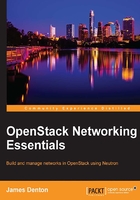
System requirements
OpenStack components are intended to run on standard hardware that ranges from desktop machines to enterprise-grade servers. For optimal performance, the processors of the compute nodes should support virtualization extensions, such as Intel's VT-x or AMD's AMD-v technologies. When using virtualization software such as VirtualBox, it may not be possible to extend certain virtualization features to the virtual machines running inside the OpenStack cloud, which could result in degraded performance. For demonstration purposes, however, deploying in a virtual machine can offer a similar experience to deploying on hardware, but in a simplified manner.
OpenStack currently supports numerous Linux distributions, including CentOS, Fedora, Red Hat Enterprise Linux, openSUSE, SUSE Linux Enterprise Server, and Ubuntu. This book assumes that the CentOS 7.1 Server operating system has been installed prior to the installation of OpenStack using RDO. You can download CentOS Server from https://www.centos.org/ or from the mirrors listed on the page at https://www.centos.org/download/mirrors/.
Note
A minimal ISO is all that is needed to build a fully functioning environment. At the time of writing this, the latest downloadable ISO is named CentOS-7-x86_64-Minimal-1511.iso.
In order to support all of the Neutron features discussed in this book, a minimum kernel version of 3.10.0-229.20.1.el7.x86_64 is recommended.
This book assumes OpenStack will be installed on a single virtual machine that meets the following minimum requirements:
